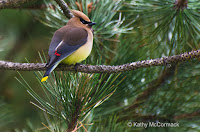CEDAR WAXWING
CEDAR WAXWING (Bombycilla cedrorum) – (See images below)
DESCRIPTION: The Cedar Waxwing has a flat head crest and a black mask around the eyes. The head is cinnamon brown, the back and the upper part of the wings are light brown. The lower part of the back and the wings is grey. The square tail is dark grey with a yellow edge. The under parts are yellowish. The wing secondaries have red waxy tips (hence the bird’s name). Sexes are similar. The bird is about 15 cm (6 inches) long.
VOICE: https://www.xeno-canto.org/species/Bombycilla-cedrorum
NAME: The English name ‘Cedar’ and the Latin species name ‘cedrorum’ refer to the diet habits of this bird (cedar fruit). The name ‘Waxwing’ refers to the bright red tips of some of the bird’s wing feathers. The Latin genus name ‘Bombycilla comes from Greek and means ‘silky tail’, in reference to the soft plumage of the bird.
HABITAT: Wooded areas in the wild, and increasingly in more urban areas with berry trees.
DIET: In the winter, these waxwings feed on cedar berries and other wild or ornamental shrub berries, and cultivated berries, that they swallow whole. In the summer they will also eat insects. Sometimes they can get drunk when eating too many over ripe, fermented fruit, and can even die from alcohol intoxication.
NESTING: Several cedar waxwing nests can be found in the same area. The nest is a cup-like structure built in a tree, and sometimes the materials may be ‘borrowed’ from the nest of other bird species. An average of five light blue eggs are laid, which are incubated by the female. The young are fed by both parents.
DISTRIBUTION: The breeding range of the cedar waxwing encompasses the southern half of Canada and the northern half of the USA. It is a year-round resident in the latter area. It migrates to the southern part of the USA and Mexico.
DISTRIBUTION MAP: https://en.wikipedia.org/wiki/Cedar_waxwing#/media/File:Cedar_Waxwing-rangemap.png
ON PEI: This species of waxwing breeds on Prince Edward Island. It is fairly common throughout the year except in winter, where it is uncommon or displays ‘irruptive’ behavior. This means that flocks of cedar waxwings will forage wherever they find food sources, which are obviously more scarce in the winter.
CONSERVATION: The population of this species appears to be relatively stable and is not at risk currently.
NOTES: Cedar waxwings are social birds that gather in flocks to forage for berries.
SIMILAR SPECIES: The cedar waxwing is sleeker than the Bohemian Waxwing. Here’s an article to help distinguish between the two species.
REFERENCES: https://www.thespruce.com/cedar-waxwing-identification-385977
https://www.mba-aom.ca/jsp/toc.jsp (Maritimes Breeding Bird Atlas)
http://www.nhptv.org/natureworks/cedarwaxwing.htm (New Hampshire PBS)
https://www.audubon.org/field-guide/bird/cedar-waxwing
https://www.borealbirds.org/bird/cedar-waxwing
https://en.wikipedia.org/wiki/Cedar_waxwing
https://www.allaboutbirds.org/guide/Cedar_Waxwing/id
https://nature.mdc.mo.gov/discover-nature/field-guide/cedar-waxwing (Missouri Department of Conservation)
DESCRIPTION: The Cedar Waxwing has a flat head crest and a black mask around the eyes. The head is cinnamon brown, the back and the upper part of the wings are light brown. The lower part of the back and the wings is grey. The square tail is dark grey with a yellow edge. The under parts are yellowish. The wing secondaries have red waxy tips (hence the bird’s name). Sexes are similar. The bird is about 15 cm (6 inches) long.
VOICE: https://www.xeno-canto.org/species/Bombycilla-cedrorum
NAME: The English name ‘Cedar’ and the Latin species name ‘cedrorum’ refer to the diet habits of this bird (cedar fruit). The name ‘Waxwing’ refers to the bright red tips of some of the bird’s wing feathers. The Latin genus name ‘Bombycilla comes from Greek and means ‘silky tail’, in reference to the soft plumage of the bird.
HABITAT: Wooded areas in the wild, and increasingly in more urban areas with berry trees.
DIET: In the winter, these waxwings feed on cedar berries and other wild or ornamental shrub berries, and cultivated berries, that they swallow whole. In the summer they will also eat insects. Sometimes they can get drunk when eating too many over ripe, fermented fruit, and can even die from alcohol intoxication.
NESTING: Several cedar waxwing nests can be found in the same area. The nest is a cup-like structure built in a tree, and sometimes the materials may be ‘borrowed’ from the nest of other bird species. An average of five light blue eggs are laid, which are incubated by the female. The young are fed by both parents.
DISTRIBUTION: The breeding range of the cedar waxwing encompasses the southern half of Canada and the northern half of the USA. It is a year-round resident in the latter area. It migrates to the southern part of the USA and Mexico.
DISTRIBUTION MAP: https://en.wikipedia.org/wiki/Cedar_waxwing#/media/File:Cedar_Waxwing-rangemap.png
ON PEI: This species of waxwing breeds on Prince Edward Island. It is fairly common throughout the year except in winter, where it is uncommon or displays ‘irruptive’ behavior. This means that flocks of cedar waxwings will forage wherever they find food sources, which are obviously more scarce in the winter.
CONSERVATION: The population of this species appears to be relatively stable and is not at risk currently.
NOTES: Cedar waxwings are social birds that gather in flocks to forage for berries.
SIMILAR SPECIES: The cedar waxwing is sleeker than the Bohemian Waxwing. Here’s an article to help distinguish between the two species.
REFERENCES: https://www.thespruce.com/cedar-waxwing-identification-385977
https://www.mba-aom.ca/jsp/toc.jsp (Maritimes Breeding Bird Atlas)
http://www.nhptv.org/natureworks/cedarwaxwing.htm (New Hampshire PBS)
https://www.audubon.org/field-guide/bird/cedar-waxwing
https://www.borealbirds.org/bird/cedar-waxwing
https://en.wikipedia.org/wiki/Cedar_waxwing
https://www.allaboutbirds.org/guide/Cedar_Waxwing/id
https://nature.mdc.mo.gov/discover-nature/field-guide/cedar-waxwing (Missouri Department of Conservation)
 |
| Cedar waxwing, PEI, by Kathy McCormack |
 |
| Cedar waxwing, PEI, by Matt Beardsley |
 |
| Cedar waxwing, PEI, Matt Beardsley |